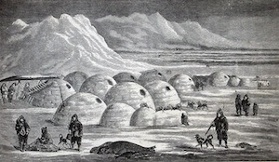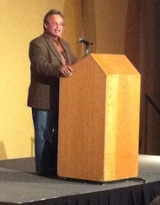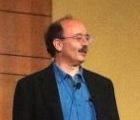Dr. Joe Lstiburek Surprises Passive House Conference Attendees

At the Passive House Conference in Denver this past week, Dr. Joe Lstiburek gave the keynote address at the opening plenary (or plenum, as Henry Gifford would say) session. His words, clever as always, added some nice historical perspective to what the Passive House folks are doing but also caught some people off guard. Read on, and I’ll tell you more about that.
A historical perspective on Passive House
First, the history. Joe went way back and started by saying that the igloo built by Eskimos was the first Passive House. It uses ice, with an R-value of 2 per inch but with very thick walls. It has an air-lock entry to minimize infiltration. It has minimal glazing. And, Canuck Joe said, it’s Canadian!
 Jumping to modern times, Joe discussed the history of energy efficiency and mentioned that that efficiency movement split into two camps back in the ’70s: those who pushed for superinsulated houses and the advocates of passive solar, or “mass and glass,” as Joe called it. (The passive solar camp has since turned into the renewables camp, with a great emphasis on converting solar energy into electricity with photovoltaics.)
Jumping to modern times, Joe discussed the history of energy efficiency and mentioned that that efficiency movement split into two camps back in the ’70s: those who pushed for superinsulated houses and the advocates of passive solar, or “mass and glass,” as Joe called it. (The passive solar camp has since turned into the renewables camp, with a great emphasis on converting solar energy into electricity with photovoltaics.)
Back in the ’70s, though, that camp was focused on capturing the heat from the sun in all kinds of ways. Joe mentioned a few and then said, “If you need something like rock-bed heat storage, you’ve made a mistake.”
Why did he say that? “I’m a conservation guy, not a renewables guy.” In the end, that’s what explains his interest in the Passive House program, I believe.
Following that introduction, Joe launched into the work he did in the early ’80s building superinsulated houses. He explained that he was using the Perfect Wall idea first published by N.B. Hutcheon (a Canadian, of course) in 1964. He discussed the R-2000 program in Canada and how it became a boutique program because of unrealistic expectations.
He also showed a lot of photos of his early projects and the failures they had to work through. My favorite was the house where they were going to embed ducts in the slab and then had to fight to get them to stay down as they floated in the wet concrete. That must have been a fun day! It’s also one of the reasons Joe loves scotch so much.
The reason he was doing that work in the early ’80s, though, is that he didn’t quit the profession. In 1980, after hitting a low point in his life, he was living in his mother’s basement and ready to quit the profession and do something different. Then he went to hear Amory Lovins speak in Toronto and got inspired to redouble his efforts. We’re lucky that he did because his work and his company, Building Science Corporation, have helped to blaze the trail for those of us who came afterward.
in the early ’80s, though, is that he didn’t quit the profession. In 1980, after hitting a low point in his life, he was living in his mother’s basement and ready to quit the profession and do something different. Then he went to hear Amory Lovins speak in Toronto and got inspired to redouble his efforts. We’re lucky that he did because his work and his company, Building Science Corporation, have helped to blaze the trail for those of us who came afterward.
Does he or doesn’t he?
Joe and his colleague Professor John Straube have been critical of the Passive House program. In his article, Just Right and Airtight, Joe wrote, “The group that really has me confused are the PassivHaus folks who are pushing 0.6 ach@50Pa.” In the next paragraph, he wrote:
Have you any idea how difficult it is to get to 0.6 ach@50 Pa? The number doesn’t seem to be based on anything that makes any sense. It is less than half the R-2000 number [1.5 ach@50 Pa] that didn’t make any sense. What I have been more or less able to figure out is that the 0.6 ach@50 Pa doesn’t come from any energy conservation rationale directly; it seems to be based on the need to prevent moisture problems in highly insulated building enclosures. That is the argument for the number 0.6 ach@50 Pa as I understand it. Never mind that the number, in itself, makes no sense as you can easily design highly insulated building closures without moisture problems that are not anywhere that tight.
He didn’t really raise this issue in his talk, and I think that caught some people off guard. One person told me afterward he was disappointed in the talk because Joe seemed too nice toward the program. He wasn’t sure that Joe was sincere. I guess I can see how someone might think that if they know of his previous criticism and then hear the talk, but when I put it all in context, it does make sense.
First, Joe is a conservation guy, and Passive House is an extreme conservation program. Second, Joe invited Katrin Klingenberg to speak at Building Science Summer Camp this year and gave an impassioned plea at the end of her talk not to let the program become a boutique program like R-2000 had. Third, I was hanging out with Joe and Kat the night before his talk (and drinking plenty of scotch), and I can tell you that he really does have a great interest in and affection for the Passive House program.
You can find another clue to where he stands on this issue in a comment he made during the annual crawl space Twitterview at Building Science Summer Camp this year. Asked if Passive House is an asinine program, he responded, “No, you just need to keep the good parts of Passive House and change the bad parts. And it needs to evolve. A boutique program that impacts a few hundred homes doesn’t solve anything.”
Joe concluded his talk by saying, “We’re family,” and he meant it.
I’d like to hear more about where he thinks the Passive House Standards should go, especially regarding the issue of air leakage, but the substance of his talk didn’t surprise me. What did surprise me, however, was that he gave his whole talk without a single F-bomb!
Related Articles
Combobulating the Perfect Wall – The Basics of Control Layers
Why Should I Care About the Passive House Program?
Quick Report on the Passive House Conference in Denver
Just Right and Airtight, by Joe Lstiburek (Building Science Corp.)
The Passive House (Passivhaus) Standard—A comparison to other cold climate low-energy houses, by John Straube (Building Science Corp.)
Allison A. Bailes III, PhD is a speaker, writer, building science consultant, and the founder of Energy Vanguard in Decatur, Georgia. He has a doctorate in physics and writes the Energy Vanguard Blog. He also has a book on building science coming out in the fall of 2022. You can follow him on Twitter at @EnergyVanguard.
Image of igloos in the public domain, from Wikimedia Commons.
This Post Has 18 Comments
Comments are closed.

Regarding the .6 ach50, it
Regarding the .6 ach50, it would have been good to hear him expand on it. But I have known/seen/spoke with him since 1999. he has always been a practical person, and durability is his first priority.
So once we have the ACH way lower than required for durability reasons, and you’ve built a robust envelope that can tolerate a little moisture, then there is no need to dedicate time or energy there.
Put those resources elsewhere so that they can add value.
Nice point about the Igloos. Gotta love uncle Joe.
-Rob
Yeah Allison. I admit I was
Yeah Allison. I admit I was looking forward to a firestorm but other than a few gentle jabs at Wufi and “just build what works” he was rather nice. Blunt but nice – I liked it.
Joe is always a fun guy to
Joe is always a fun guy to listen to. I wish I could have heard it but I was at the EEBA Conference in Arizona. Why do these 2 organizations seem to schedule big events at the same time?
That’s what happen as we get
That’s what happen as we get older…we soften a bit and begin to refrain from using F-bombs 🙂
Seriously, though, I suppose it doesn’t matter if Dr. Joe’s not a renewables guy. I see conservation and renewables as two somewhat separate things, although I also view extreme conservation as a prerequisite to making wide-spread adoption of renewables feasible.
Dr. Joe is also a climate change denier, isn’t he? At least, that’s the impression I have. But as long as he’s championing extreme conservation, I don’t think climate change denial on his part would detract at all from the positive outcome of his work, anyway…
Allison,
Allison,
Thanks so much for sharing with those of us headed for our mother’s basements…
I can’t see PH being a "
I can’t see PH being a “boutique” program hinging on this. It requires hours of consultation from certified experts. This is a “Custom Design, Custom Building” paradigm. It is “boutique” by its very nature.
@Greg
@Greg
I agree. I have had many conversations about the value of “highly designed” homes.
It seems after tens of thousands of dollars spent on architects and various consultants we are way down on the payback curve.
-Rob
Ha, just thinking, I remember
Ha, just thinking, I remember a seminar once where Joe astutely pointed out that in order for sustainability to be sustainable, sustainability consultants will need sustainable incomes.
-Rob
at risk of being redundant,
at risk of being redundant, Sweden has already achieved this, and they did not do it by creating model by which every house required detailed consultation on energy consumption. They did it by moving the entire industry to high performance model wall systems. The PH analysis is great, but as far as becoming the way the industry builds houses – its dead on arrival. They won’t pay for an architect to design a house, never mind a PH consultant.
My experience is that most
My experience is that most builders have a ‘herd’ mentality. They look around constantly to find a style or floor plan that seems to sell and they copy it. If they can get their hands on an original set of plans, they’ll copy that, too. No need to pay an architect when you can just run copies of a purloined set of plans.
In this same vein, builders tend to react negatively to anything that might even cost them a little money. So, getting them to pay for a rating or for any form of consulting is akin to drawing blood. However, if you look you can still find a progressive few who understand the big picture and build accordingly. In my mind, these are the builders who’ll survive.
What? So you are saying the
What? So you are saying the builders that cut corners and do whatever they can do to make more profits will not survive, and a builder who spends thousands on a certification and special consultant – they will survive?
I don’t follow.
Greg, I hope that you are
Greg, I hope that you are just kidding…? Cutting corners when building any type of building does not go unnoticed. It shows up in many ways, including high energy bills.
More to the point: There are numerous examples available now of builders who exclusively build and market energy efficient homes, even green or net-zero homes, who have customers waiting in line. One national example is Meridian Homes. Their basic home is an Energy Star Version 3.0 and they offer net-zero homes. They’ve been doing so well that they are looking at going public with a stock offering, while their competition is crying the blues. Meridian homes are even still selling in Las Vegas, where the market is one of the worst in the USA.
However, you can’t just build an energy efficient or green home & expect it to sell. You have to market it as well and, if you do, then there’s proof that customers will seek you out.
Here is a link to Meridian: http://meridianhomesinc.com/green-principles
@Ken, yes, I am familiar with
@Ken, yes, I am familiar with Meridian, and many others. Yet their numbers are dwarfed by the volume of uncaring builders serving the vastly greater portion of the population, who have little interest in these issues. These builders will not line up for PH. Its up to us to map out a path to higher performance that they will buy into. Expensive consulting on a house by house basis is not the paradigm.
@Greg, now I understand
@Greg, now I understand better as to where you were going with your question. Our company has been in the business of conducting energy audits since our founding in Sept. of 1979 and I have hit my head against the builder’s wall many times. There is a significant percentage of them who will never build anything better than what basically meets code. I don’t think there is anything we can do to change their business philosophy.
However, I do think that more & more builders are beginning to see the light and these are the ones we should encourage. I agree that we need to come up with a lower fee structure and a systematic approach to PH. As I stated earlier, I strongly feel that the enlightened builders will continue to gain market share while the stubborn ones will fade away. Just my opinion…
Encouraging the good ones is
Encouraging the good ones is great, but the sooner we bring the status quo on board, the sooner we will begin to make a difference in the way we build as a country and the amount of energy we use.
A lower fee structure for PH is NOT the solution. Its still a One House at a Time/Custom Solution paradigm.
No, what you need to do is take away a series of recommendations on building practices that any builder can implement – without the PH analysis.
You have to let go of that friends, ’cause it ‘aint never gonna happen.
PH provides a pathway from
PH provides a pathway from the “Pretty Good House” to the Net Zero House. Once we’ve achieved all that we can from lowest hanging fruit in simple conservation techniques we have to address homes at the design stage to take them up to the next level. PH is a really good tool for doing that. I would argue that many PH projects in Europe are not officially certified because the design / build teams learned which methods were paying off and then repeated those methods, without going the extra mile to certify. If PH can provide that framework here in the states we can move to large scale net zero at affordable rates. Unfortunately, the trail blazers have the burden of the cost, but it’s important to recognize that they also gain the recognition. Recognition is what builders need in a highly competitive market.
I heard Joe speak candidly
I heard Joe speak candidly (for a Canadian) about Passive House at the DOE 2012 Technical Update.It would have been fun were frank while speaking to this group. But he understands we all aim at the same target, a complete, civilized life that we can sustain on this planet for thousands of years. In the long view, all of these experiments will lead to the ultimate balance Joe’s looking for, the optimum, practical structures that consume virtually no energy and work economically and culturally for the mass market. He’s in the 98-percent energy crowd of people that want a responsible house but don’t want lives that revolve around it.
Very interesting!
Very interesting!